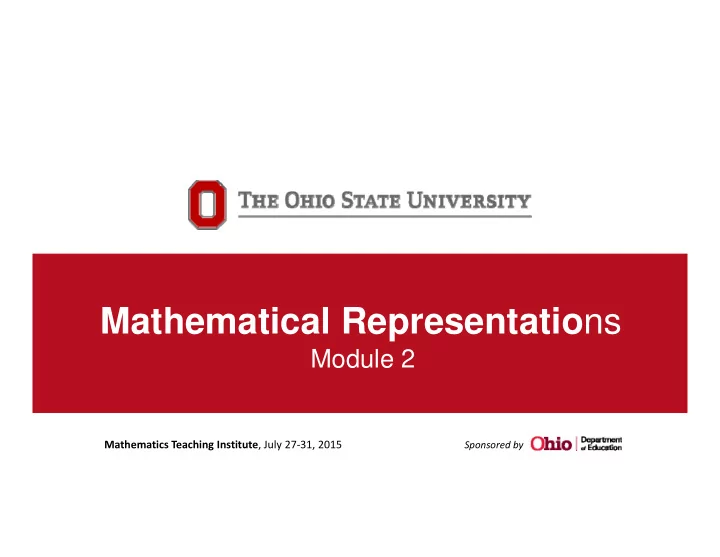

Mathematical Representatio ns Module 2 Mathematics Teaching Institute , July 27 ‐ 31, 2015 Sponsored by
Mathematics Teaching Institute July 27-31, 2015 The ratio of boys to girls in a class is 5 to 3. After six girls join the class, the number of boys and girls in the class is the same. How many students are in the class now? Post solutions on chart paper. 2 Sponsored by
Mathematics Teaching Institute July 27-31, 2015 Consider Student Work Samples What mathematics does each student know? What do we learn about each child based on their responses? What are the advantages and disadvantages of each representation? 3 Sponsored by
Mathematics Teaching Institute July 27-31, 2015 Student Work Sample #1 4 Sponsored by
Mathematics Teaching Institute July 27-31, 2015 Student Work Sample #2 5 Sponsored by
Mathematics Teaching Institute July 27-31, 2015 Student Work Sample #3 6 Sponsored by
Mathematics Teaching Institute July 27-31, 2015 Student Work Sample #4 7 Sponsored by
Mathematics Teaching Institute July 27-31, 2015 Student Work Sample #5 8 Sponsored by
Mathematics Teaching Institute July 27-31, 2015 Student Work Sample #6 9 Sponsored by
Mathematics Teaching Institute July 27-31, 2015 If instruction emphasizes only one model or one representational type, then the mathematical tools that children acquire is limited. 10 Sponsored by
Mathematics Teaching Institute July 27-31, 2015 When we talk about graphing ratios, would the graph be continuous or discrete, and why? Is graphing a relationship defined by a ratio different from graphing a proportional relationship? 11 Sponsored by
Mathematics Teaching Institute July 27-31, 2015 12 Sponsored by
Mathematics Teaching Institute July 27-31, 2015 Ratios Discrete Uses additive and multiplicative reasoning patterns! 13 Sponsored by
Mathematics Teaching Institute July 27-31, 2015 Dora has been asked to make cupcakes for the entire swim team. She knows that when she makes 1, 2, or 3 cupcakes how much icing she needs. How much icing will she need for the whole team of 45 swimmers? 14 Sponsored by
Mathematics Teaching Institute July 27-31, 2015 Proportions: Continuous Uses multiplicative reasoning (aka constant of proportionality)! 15 Sponsored by
Mathematics Teaching Institute July 27-31, 2015 The ratio of girls to boys in a freshman class is 4:3. The ratio of girls to boys in a sophomore class is 5:4. If we combine the two classes, what would be the ratio of girls to boys in the group? 16 Sponsored by
Mathematics Teaching Institute July 27-31, 2015 Terry has an appointment with his barber. He decides to ride his bicycle to the barber shop instead of driving. If he rides his bike at 10 miles per hour, then he gets there an hour late for his appointment. However, if he rides his bike at 15 miles an hour, then he gets there an hour early. How far does Terry live from the barber shop? 17 Sponsored by
Mathematics Teaching Institute July 27-31, 2015 A pie graph has four unequal slices representing favorite soft drink preferences for a sample of n people. Eight more people join the sample and three-fourths of them choose Coca-Cola as their favorite soft drink. This result makes the Coca-Cola slice increase to exactly 54% of the total graph. How many people were initially in the sample? 18 Sponsored by
Mathematics Teaching Institute July 27-31, 2015 A survey about favorite desserts reports: 12% of the sample prefer cake 4% of the sample prefer cookies 28% of the sample prefer ice cream 40% of the sample prefer chocolate What is the smallest number of people that could have taken the survey? 19 Sponsored by
Mathematics Teaching Institute July 27-31, 2015 � � If and , � � what is the ratio of to ? Adapted from “Contest Problem Book V” from 1986 AHSME 20 Sponsored by
Mathematics Teaching Institute July 27-31, 2015 60% of the members of a computer club were girls. Later, 15 boys joined the club. With the addition of boys, do you expect the percentage of girls to be larger than 60% or smaller? Is it possible to find the percentage of female members in the computer club after the addition of boys? If so, what is the new percentage of females? If not, explain what other information you would need to determine the percentage of girls in the computer club. 21 Sponsored by
Mathematics Teaching Institute July 27-31, 2015 As the star player of a basketball game stands at the free throw line, the announcer states that he had hit 78% of his free throws that year. The star player misses the first shot and makes the second. Later in the game he is fouled for the second time. As he moves to the free throw line, the announcer states that he had made 76% of his free throws so far that year. Can you determine how many free throws this player had attempted and how many he had made that year? 22 Sponsored by
Mathematics Teaching Institute July 27-31, 2015 How might we make the different types of representations accessible to children? What mathematical points are important to be made explicitly in class? What other problems might be used to help children acquire these different representational schemes? 23 Sponsored by
Recommend
More recommend